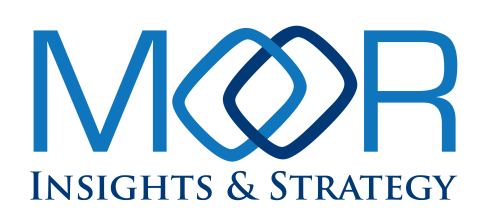
The Moor Insights & Strategy team hopes you had a great week — and for those in the United States, an enjoyable Independence Day weekend!
This week, Melody Brue attended Wimbledon with IBM. Patrick Moorhead is at AWS with Robert Kramer, Matt Kimball, and Jason Andersen.
Our MI&S team published 11 deliverables:
3 Forbes Insight Columns
2 MI&S Research Notes
3 MI&S blogs
3 Podcasts
Over the last two weeks, the press quoted us with 6 citations. They wanted to hear about Lenovo, Nutanix, NVIDIA, and Samsung.
MI&S Quick Insights
CentOS has reached end of life — This week was the official CentOS 7 end of life from Red Hat, something of a sad milestone in the world of software development and platforms. There are tons of companies that started their businesses using CentOS as a reliable and no-cost operating system. It was also easy for those companies to test on CentOS and provide support for RHEL, which was a comfort to many enterprises. Unlike some members of the community, I don’t harbor a grudge against Red Hat for EOLing CentOS; the company can direct resources however it likes. But I do wonder how much this decision helps Red Hat in the long run. The company took a big PR hit on this, and there is no shortage of other options available besides buying a RHEL subscription. This includes CentOS alternative Rocky Linux as well as other commercial options from SUSE and Ubuntu. I’m not sure we will fully appreciate the impact of this move for a while, but in any case I would have been remiss if I let the date pass without saying something.
AI can teach other AIs what?! This week there were two announcements that suggested we are starting to see LLMs being used to help out other LLMs. First was the announcement of CriticGPT from OpenAI. CriticGPT looks at the code generated by ChatGPT and suggests fixes. The best analogue I can use to describe it is that CriticGPT is like using a GPT for unit testing—or at least another set of eyes on your code. While it’s interesting, I wonder why a developer wouldn’t consider a model specifically tuned to their language and tooling preference for more accurate recommendations to begin with? In the second announcement we see that Gemma 2 from Google has a new feature called Knowledge Distillation, which is a way for Gemma to be used to train smaller LLMs. This capability was used on last week’s release. The 27-billion-token Gemma model was used to train the 9-billion-token model. My suspicion is that this will reduce the amount of human-centered reinforcement training by allowing a smaller model to leverage that investment from a larger model. It will be very interesting to see if this is a new best practice or not, as the human part of training is a big cost item for LLMs.
CentOS has reached end of life — This week was the official CentOS 7 end of life from Red Hat, something of a sad milestone in the world of software development and platforms. There are tons of companies that started their businesses using CentOS as a reliable and no-cost operating system. It was also easy for those companies to test on CentOS and provide support for RHEL, which was a comfort to many enterprises. Unlike some members of the community, I don’t harbor a grudge against Red Hat for EOLing CentOS; the company can direct resources however it likes. But I do wonder how much this decision helps Red Hat in the long run. The company took a big PR hit on this, and there is no shortage of other options available besides buying a RHEL subscription. This includes CentOS alternative Rocky Linux as well as other commercial options from SUSE and Ubuntu. I’m not sure we will fully appreciate the impact of this move for a while, but in any case I would have been remiss if I let the date pass without saying something.
AI can teach other AIs what?! This week there were two announcements that suggested we are starting to see LLMs being used to help out other LLMs. First was the announcement of CriticGPT from OpenAI. CriticGPT looks at the code generated by ChatGPT and suggests fixes. The best analogue I can use to describe it is that CriticGPT is like using a GPT for unit testing—or at least another set of eyes on your code. While it’s interesting, I wonder why a developer wouldn’t consider a model specifically tuned to their language and tooling preference for more accurate recommendations to begin with? In the second announcement we see that Gemma 2 from Google has a new feature called Knowledge Distillation, which is a way for Gemma to be used to train smaller LLMs. This capability was used on last week’s release. The 27-billion-token Gemma model was used to train the 9-billion-token model. My suspicion is that this will reduce the amount of human-centered reinforcement training by allowing a smaller model to leverage that investment from a larger model. It will be very interesting to see if this is a new best practice or not, as the human part of training is a big cost item for LLMs.
Liquid cooling. Who would have thought datacenter plumbing would ever be cool? Strangely, I did when I wrote about it in early 2023 and again in early 2024. While sustainability is critical, the needs of enterprise IT are more rooted in the pragmatic: cooling chips that are hot and getting hotter, reducing power consumption of industrial HVAC equipment, and reallocating that power toward computational work. With these factors in play, each server vendor and infrastructure provider has made its liquid cooling strategy a more prominent part of its core value positioning.
I still believe that the best innovation around liquid cooling exists in the community of solutions providers such as JetCool, ZutaCore, LiquidStack, and CoolIT that are delivering greater levels of cooling efficiency to the enterprise datacenter. Because of this, it is critical that server vendors embrace this community and the open standards to which many of them are designing products.
Is the AI game over so early? Has NVIDIA won the battle and the war? The company’s hardware and software portfolio, combined with the broad adoption of its CUDA platform in the market, can certainly make the AI training game look like it’s already locked up. I’m not convinced.
Companies like Cerebras will continue to win in organizations with specific needs and in specific verticals. But Cerebras isn’t a real threat to NVIDIA’s dominance.
AMD and Intel each have an opportunity to challenge the dominance of NVIDIA, but it will not be easy. The path to AI relevance is equal parts hardware and software. Perhaps more software than hardware.
AI has forever changed the IT infrastructure landscape. But the AI market is still in its early stages, and it is important for each vendor to focus on the long game and patiently invest in longer-term success. Further, focusing on the long tail and stickiness of inference, where the value of AI is realized, is equally important.
HYCU, Inc. aims to revolutionize data protection. For those unfamiliar with HYCU, it is a Boston-based company recognized for its data protection solutions across on-premises, public cloud, hybrid, and SaaS platforms.
While SaaS applications offer many benefits, they also present challenges for data management strategies. Discover how HYCU addresses these challenges with its R-Cloud platform, providing Data Protection as a Service (DPaaS).
My colleague Melody Brue covered this week’s Samsara Beyond user meeting in a nearby article, but I’ll offer my opinion of an IoT-related product announcement—an asset tracker. This new device is functionally similar to Apple AirTags, but it’s the size of a fun-size candy bar, has a 4-year battery life, and is designed for industrial applications. It connects via Bluetooth to any Samsara gateway in a nearby truck, trailer, or warehouse. It’s a high-power Bluetooth Class 1 device (100 mW), so the range is up to 100 meters, sufficient for most industrial settings, especially since intermittent connectivity is OK for most tracking applications. I like this product for two reasons. First, it’s an excellent use of Samsara’s existing network—the “Connected Operations Cloud,” which connects more than 2 million gateways and adds no additional connectivity costs for asset tags. The proprietary network simplifies setup by eliminating physical activation. Second, it’s integrated with the operations applications and workflows that Samsara customers use daily, so it’s useful right out of the box. I expect rapid uptake by Samsara customers.
Globant has launched its Adobe Studio to assist brands in getting more out of their Adobe implementations by applying AI and its in-house expertise with Adobe’s enterprise offerings. The goal is to help brands enhance their digital marketing strategies using Adobe Experience Cloud platforms. This could be attractive for companies looking to optimize their Adobe investments and improve personalization, automation, and efficiency in marketing campaigns.
IBM has finalized its acquisition of the Super iPaaS data integration platform from Software AG, including the StreamSets Inc. and webMethods businesses. This technology helps enterprise customers improve real-time integration, API management, and data ingestion to improve data quality and break down data silos across hybrid environments.
As organizations seek to integrate ERP data into intelligence platforms and incorporate SaaS application data, high-powered integration tools and platforms like Super iPaaS will become increasingly important. This acquisition fits well with the IBM watsonx data platform, which uses an open architecture lakehouse for both structured and unstructured data. IBM plans to include Super iPaaS features in watsonx.data.
For more on Super iPaaS, see my research paper about it from November 2023.
- Xbox Live was down for most of a day last week. Given that Xbox Live serves as the backbone for Microsoft’s cloud gaming, the outage affected tens of millions of gamers worldwide. No word yet on what caused the outage.
- Nintendo says that it isn’t interested in using generative AI in its first-party titles based on IP concerns, and added that it doesn’t believe it needs AI to deliver a quality product.
- Qualcomm and Manchester United have finally launched their front-of-shirt partnership, which puts the Snapdragon logo on the front of the team’s jersey for the 2024–2025 season. To commemorate this, Qualcomm launched an app that uses the jersey as a target for an AR experience that the company will use to connect with Manchester United’s 1.1 billion fans.
This week, after receiving all required regulatory approvals, IBM completed its acquisition of StreamSets and webMethods from Software AG for a purchase price of €2.13 billion. StreamSets adds real-time data transformation capabilities for diverse data streams to watsonx. IBM intends to embed the technology in watsonx.data, IBM’s AI data platform, as a premium feature. StreamSets is a savvy addition to watsonx.data because it simplifies the daunting process of connecting continuous data streams from diverse sources to increasingly intelligent applications in connected enterprises. StreamSets offers a high-productivity visual environment with a comprehensive set of built-in data transformation tools that enable developers to ingest, filter, enrich, mask, integrate, and deliver high-volume data streams. webMethods is an integration platform as a service (iPaaS) product that enables users to deploy and run integrations anywhere, respecting local data sovereignty requirements while unifying output flows and centralizing management. Combining these two product sets expands IBM’s ability to utilize real-world, real-time information as a primary source of truth in enterprise AI applications.
- T-Mobile continues to capture performance leadership on Ookla benchmarks, continuing to beat Verizon and AT&T on media download speeds and coverage. While all carriers continue to improve, T-Mobile is maintaining a sizable lead, even in rural areas.
- I believe that many of the advances we are seeing for things like RedCap and 3GPP Rel. 18 will ultimately enable the new use cases that 5G always promised, as long as the carriers actually deploy standalone 5G nationwide.
- RingCentral announced that MedCare, a medical services provider, has successfully implemented RingCentral’s integrated solutions. MedCare chose RingCentral because its integrated platform addressed MedCare’s telephony needs and allowed for seamless integration of other crucial communication services including RingSense AI and RingCentral Contact Center. The medical company says the implementation of RingEX, RingCentral’s cloud phone solution, has improved customer experience and freed employees from their desks. With RingCentral, MedCare reports a 40% reduction in call wait times and substantial time savings in call reviews and agent coaching. MedCare also anticipates a 20% increase in customer issue resolution and deal closure speed upon fully deploying RingSense for RingCX. RingCentral has made a big push into the healthcare space with more tailored solutions for critical customer experiences.
- I recently published an article about Microsoft’s Work Trend Index. One of the observations from the study was that the length of meetings has varied for companies using Microsoft Copilot. My assessment of this was that it was likely due to several changes, including time saved from not having to take notes, which resulted in shorter meetings. Conversely, an explanation for longer meetings could be more available thinking and collaboration time due to Copilot productivity gains. U.K.-based mobile charging company Joos has given a very concrete explanation of how the company uses AI to boost meeting efficiency. Copilot’s ability to quickly generate meeting recaps with notes and action items has changed how the company structures its meetings. Joos said it reviews the Copilot meeting recaps to see where participants have veered off topic. Using this information, the company has streamlined agendas to be more effective and skip over redundancies. I like this use case and hope to see more things like this in the future as people realize the value of using Gen AI to increase efficiency.
- Last week at its annual conference and analyst event, Samsara, which makes an operations platform used by industrial companies, announced new solutions aimed at improving operational efficiency, safety, and sustainability. The company’s Connected Operations Cloud platform provides the foundation for these solutions, including Connected Training for driver education, Connected Workflows for task automation, and asset tracking and management tools. Additionally, Samsara has integrated AI into its safety features, introducing real-time detections for potential hazards. These developments demonstrate the company’s focus on data-driven insights and proactive risk management for employee safety and to meet evolving client needs.
The FTC is going after PC manufacturers that use warranty void stickers to scare customers away from repairing their own notebooks—even when their warranties explicitly state that repairs are allowed. The FTC sent letters to ASrock, Gigabyte, and Zotac regarding these stickers, warning the companies not to threaten customers.
Who’s excited about the Olympics in Paris 2024?! The games are about a month away, and potential security issues such as cyberattacks, are rising. Here are some concerning potential problems.
- Supply chain attacks could target vendors of the Paris 2024 Olympics.
- Russia might launch cyberattacks on key businesses supporting the Games in retaliation for banning its athletes.
- Disinformation campaigns spreading false information about violence, terrorism, or health risks could discourage attendance and participation.
- Cybercriminals could use AI tools for phishing, malware, and deepfake attacks during the Games.
This week, Qualcomm announced that Snapdragon is now the official front-of-shirt partner for Manchester United Football Club’s men’s, women’s, and academy teams. The Snapdragon logo will be featured on the home, away, and third kits, marking the seventh front-of-shirt partnership in the club’s history. As noted in Anshel Sag’s comment in the AR section above, Snapdragon technology will also be used to enhance fan experiences.
SAP has announced the upcoming release of SAP Green Ledger, a tool that connects emissions and financial data, and the general availability of SAP Green Token, which enhances material traceability and transparency. These solutions aim to help businesses make more informed, sustainable decisions by understanding the financial impact of their environmental footprint and ensuring the ethical sourcing of materials.
Columns Published
- Intel’s Lunar Lake Changes Everything About X86 — Anshel Sag
- Arm Flexes Its Big Guns for Next-Generation AI Devices — Anshel Sag
- SAP Charts a Course for the AI-Driven Enterprise at Sapphire 2024 — Melody Brue and Robert Kramer
Research Notes (MI&S)
Blogs Published (MI&S)
- NatWest — The Case for the Mainframe in a Hybrid Cloud — Patrick Moorhead
- WWDC 2024: Apple Intelligence, OS Updates and Other Highlights — Anshel Sag
- Cisco Finds Its AI Hyperdrive at Cisco Live U.S. 2024 — Will Townsend
Podcasts
Game Time Tech by Moor Insights & Strategy (Melody Brue and Robert Kramer)
Hot Desk Podcast (Melody Brue and Robert Kramer)
Citations
Lenovo / Matt Kimball / TechTarget
Matt Kimball discusses how Lenovo’s combination of AI and sustainability initiatives aligns with the increasing demands of the industry.
Nutanix / Matt Kimball / Network World
Matt Kimball on Nutanix targeting dissatisfied VMware customers.
NVIDIA / / Patrick Moorhead / Insider Monkey
Patrick Moorhead on NVIDIA’s AI dominance and potential for pullback.
NVIDIA / Patrick Moorhead / Value Walk
ValueWalk explores an alternative to volatile NVIDIA shares for AI investors.
NVIDIA / Patrick Moorhead / FXStreet
FXS looks at options for those looking to get in on the AI stock frenzy.
Samsung / Anshel Sag / CNET
Anshel Sag’s thoughts on Samsung’s Galaxy Ring.
New Gear or Software We Are Using and Testing that is Public Knowledge
- XREAL Beam Pro handheld (Anshel Sag)
- Clicks Keyboard for iPhone 15 Pro Max (Anshel Sag)
Events MI&S Plans on Attending In-Person or Virtually (New)
- AWS Analyst Forum, July 8-10, New York – onsite (Robert Kramer)
- AWS Analyst Forum, July 8-10, New York – onsite (Jason Andersen, Robert Kramer)
- HP Imagine AI, July 11, New York – onsite (Anshel Sag)
- Siggraph, July 29-August 1 — virtual (Matt Kimball)
- AWS Analyst Forum, July 8-10, New York – onsite (Robert Kramer)
- AWS Analyst Forum, July 8-10, New York – onsite (Jason Andersen, Robert Kramer)
- HP Imagine AI, July 11, New York – onsite (Anshel Sag)
- Siggraph, July 29-August 1 — virtual (Matt Kimball)
- Black Hat, August 3-8, Las Vegas – onsite (Will Townsend)
- VMware Explore, August 26-29, Las Vegas – onsite (Matt Kimball, Will Townsend)
- Global Foundries Analyst Event, August 26-28 – onsite (Matt Kimball)
- IFA Berlin, September 6-11, Berlin, Germany – onsite (Anshel Sag)
- Oracle Cloud World, September 9-12, Las Vegas – onsite (Melody Brue, Robert Kramer)
- Connected Britain, September 11-12, London – onsite (Will Townsend)
- Salesforce Dreamforce, September 17-19, San Francisco – onsite (Robert Kramer)
- Intel Innovation, September 23-26 – onsite (Matt Kimball)
- Meta Connect, September 25, San Jose (Anshel Sag)
- Verint Engage, September 23-25, Orlando – onsite (Melody Brue)
- Infor Annual Summit, September 30-October 2, Las Vegas (Robert Kramer)
- LogicMonitor, Austin, October 2-4 (Robert Kramer)
- Teradata, October 7-10, Los Angeles – onsite (Robert Kramer)
- Zoomtopia, San Jose, October 8-9 (Melody Brue)
- MWC Americas, October 8-10, Las Vegas (Will Townsend)
- AdobeMAX, October 14-16, Miami – onsite (Melody Brue)
- Lenovo Global Analyst Summit & Tech World, Octobebr 14-17, Bellevue, WA – onsite (Matt Kimball, Paul Smith-Goodson)
- IBM Analyst Summit, October 16-18, New York City – onsite (Matt Kimball, Robert Kramer)
- WebexOne, October 21-24, Miami – onsite (Melody Brue)
- SAP SuccessConnect, October 28-30 – virtual (Melody Brue)
- GitHub Universe, October 29-30 , San Francisco – onsite (Jason Andersen)
- 5G Techritory, October 30-31, Riga (Will Townsend)
- Dell Tech Analyst Summit, early November, Austin (Matt Kimball)
- IBM, November 6 – 8, New York City (Paul Smith-Goodson)
- Fyuz, November 11-13, Dublin (Will Townsend)
- Box Analyst Summit, November 12-13, San Francisco (Melody Brue)
- Microsoft Ignite, November 18 – 22, Chicago (Robert Kramer – virtual, Will Townsend)
- Super Computing, November 18-22, Atlanta (Matt Kimball)
- AWS re:invent, Las Vegas, December 2-6 (Robert Kramer, Will Townsend)
Subscribe
Want to talk to the team? Get in touch here!
Was the Weekly Roundup forwarded to you? Subscribe here and don’t miss out on future insights!




























































































